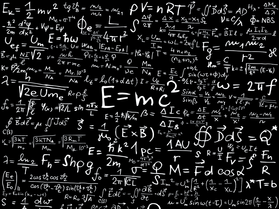
Physics is the science of matter and energy and of interactions between the two, grouped in traditional fields such as acoustics, optics, mechanics, thermodynamics, and electromagnetism, as well as in modern extensions including atomic and nuclear physics, cryogenics, solid-state physics, particle physics, and plasma physics.
Formerly called natural philosophy, physics is concerned with those aspects of nature which can be understood in a fundamental way in terms of elementary principles and laws. In the course of time, various specialized sciences broke away from physics to form autonomous fields of investigation. In this process physics retained its original aim of understanding the structure of the natural world and explaining natural phenomena.
The most basic parts of physics are mechanics and field theory. Mechanics is concerned with the motion of particles or bodies under the action of given forces. The physics of fields is concerned with the origin, nature, and properties of gravitational, electromagnetic, nuclear, and other force fields. Taken together, mechanics and field theory constitute the most fundamental approach to an understanding of natural phenomena which science offers. The ultimate aim is to understand all natural phenomena in these terms.
The older, or classical, divisions of physics were based on certain general classes of natural phenomena to which the methods of physics had been found particularly applicable. The divisions are all still current, but many of them tend more and more to designate branches of applied physics or technology, and less and less inherent divisions in physics itself. The divisions or branches, of modern physics are made in accordance with particular types of structures in nature with which each branch is concerned.
In every area physics is characterized not so much by its subject-matter content as by the precision and depth of understanding which it seeks. The aim of physics is the construction of a unified theoretical scheme in mathematical terms whose structure and behavior duplicates that of the whole natural world in the most comprehensive manner possible. Where other sciences are content to describe and relate phenomena in terms of restricted concepts peculiar to their own disciplines, physics always seeks to understand the same phenomena as a special manifestation of the underlying uniform structure of nature as a whole. In line with this objective, physics is characterized by accurate instrumentation, precision of measurement, and the expression of its results in mathematical terms.
source:
Read more: http://www.answers.com/topic/physics#ixzz2moSpwc00
Formerly called natural philosophy, physics is concerned with those aspects of nature which can be understood in a fundamental way in terms of elementary principles and laws. In the course of time, various specialized sciences broke away from physics to form autonomous fields of investigation. In this process physics retained its original aim of understanding the structure of the natural world and explaining natural phenomena.
The most basic parts of physics are mechanics and field theory. Mechanics is concerned with the motion of particles or bodies under the action of given forces. The physics of fields is concerned with the origin, nature, and properties of gravitational, electromagnetic, nuclear, and other force fields. Taken together, mechanics and field theory constitute the most fundamental approach to an understanding of natural phenomena which science offers. The ultimate aim is to understand all natural phenomena in these terms.
The older, or classical, divisions of physics were based on certain general classes of natural phenomena to which the methods of physics had been found particularly applicable. The divisions are all still current, but many of them tend more and more to designate branches of applied physics or technology, and less and less inherent divisions in physics itself. The divisions or branches, of modern physics are made in accordance with particular types of structures in nature with which each branch is concerned.
In every area physics is characterized not so much by its subject-matter content as by the precision and depth of understanding which it seeks. The aim of physics is the construction of a unified theoretical scheme in mathematical terms whose structure and behavior duplicates that of the whole natural world in the most comprehensive manner possible. Where other sciences are content to describe and relate phenomena in terms of restricted concepts peculiar to their own disciplines, physics always seeks to understand the same phenomena as a special manifestation of the underlying uniform structure of nature as a whole. In line with this objective, physics is characterized by accurate instrumentation, precision of measurement, and the expression of its results in mathematical terms.
source:
Read more: http://www.answers.com/topic/physics#ixzz2moSpwc00
 RSS Feed
RSS Feed